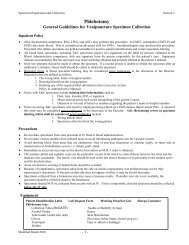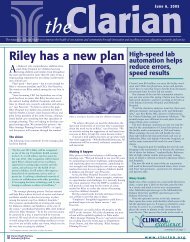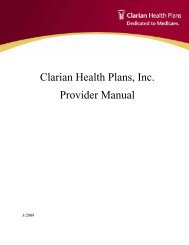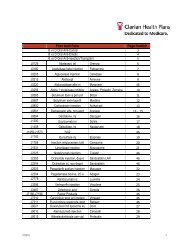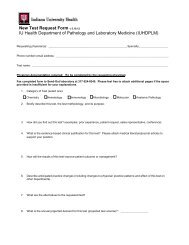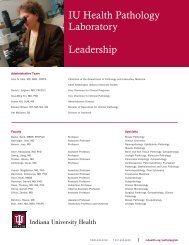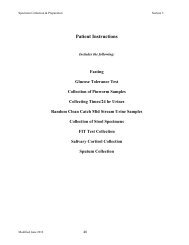Guidelines for Microbiology & Virology - IU Health
Guidelines for Microbiology & Virology - IU Health
Guidelines for Microbiology & Virology - IU Health
You also want an ePaper? Increase the reach of your titles
YUMPU automatically turns print PDFs into web optimized ePapers that Google loves.
Specimen Preparation and Collection Section 3<br />
♦<br />
♦<br />
Blood <strong>for</strong> CMV/Adenovirus/Herpes (HSV) cultures:<br />
1. Blood <strong>for</strong> viral culture is ONLY processed Monday - Friday, 7 AM to 1 PM, Saturday if received in lab by 8 AM.<br />
2. Blood MUST BE in the laboratory within 6 Hours of collection<br />
3. DO NOT REFRIGERATE! STORE AT ROOM TEMPERATURE.<br />
If viremia, fungemia, brucellosis, tularemia, bartonella, or an infection with a cell-wall deficient or fastidious bacterium<br />
is suspected, the microbiology laboratory should be contacted <strong>for</strong> special instructions.<br />
Equipment<br />
Alcohol Swabs Appropriate Blood Culture Bottles 10 - 30 ml syringe Exam Gloves<br />
Tincture of Iodine Sepp Needle/Butterfly <strong>for</strong> Venipuncture NICU: Providone-iodine<br />
Procedure (Observe Universal {Standard} Precautions):<br />
♦ Put on gloves (clean exam gloves are acceptable).<br />
♦ Disinfect the septa of the blood culture bottles utilizing 70% isopropyl alcohol. NOTE: Do not use iodine/providenceiodine<br />
to prevent septa from deteriorating.<br />
♦ Identify site <strong>for</strong> specimen collection.<br />
♦<br />
♦<br />
♦<br />
TABLE 5. Media <strong>for</strong> isolation of organisms from Blood Culture Media.<br />
CULTURE MEDIA TYPE AMOUNT OF BLOOD<br />
Bacteria/Yeast<br />
Bactec 26 Plus (Silver Label) or<br />
Bactec Peds Plus (Pink Label)<br />
Anaerobes Bactec Lytic (Purple Label) 3 – 10 ML<br />
Systemic Fungus (Histoplasma Capsulatum Adult Isolator<br />
or Cryptococcus Neo<strong>for</strong>mans) Pediatric Isolator<br />
Mycobacteria Adult Isolator 9 – 10 ML<br />
CMV/Adenovirus/HSV<br />
ACD (Yellow Top), EDTA (Purple)<br />
Heparin (Green Top: sodium or lithium))<br />
8 – 10 ML Adults<br />
0.5 – 5 ML Peds<br />
9 – 10 ML Adults<br />
0.5 – 1.5 ML Peds<br />
8 – 10 ML Adults<br />
3 ML Peds<br />
Peripheral Venipuncture/Arterial Puncture:<br />
1. Vigorously cleanse site by rubbing in concentric circles with 70% isopropyl alcohol to disinfect the skin.<br />
2. Vigorously disinfect the site by starting at the center and rub in concentric circles utilizing tincture of iodine<br />
solution <strong>for</strong> one-two minute duration. NOTE: NICU utilize betadine. For iodine sensitive patients, utilize 70%<br />
isopropyl alcohol <strong>for</strong> one-two minute duration.<br />
3. Allow the disinfectant to dry (iodine and alcohol function by drying). NOTE: Do not palpate over the site the needle<br />
will enter once the site is disinfected (to decrease contamination risk to the specimen).<br />
4. Draw blood via a syringe and needle/butterfly.<br />
5. Remove needle/butterfly and apply pressure to site until bleeding stops.<br />
6. Place blood into appropriate collection bottles/tubes. Inoculate aerobic bottle first. Refer to collection diagram. It is not<br />
necessary to change needles prior to inoculating bottles/tubes.<br />
7. If septum becomes contaminated with blood, clean with 70% isopropyl alcohol.<br />
8. Once hemostasis is obtained at puncture site, cleanse residual iodine/betadine from site with alcohol to prevent skin<br />
irritation.<br />
Line Draws<br />
1. If more than one intravascular catheter is available to obtain blood then select line least likely to be<br />
colonized/contaminated with microorganisms. Most typically it should be the newest line in; however, consider<br />
factors such as breaks into the line <strong>for</strong> blood draws, tubing changes or catheter manipulations.<br />
2. Cleanse line adapter, as needed, if one is present, vigorously with 70% isopropyl alcohol prior to obtaining<br />
specimen.<br />
3. Follow “Collection Diagram” <strong>for</strong> placing blood specimen into bottles. Inoculate aerobic bottle first.<br />
Specimen Labeling<br />
1. Label each bottle with patient label containing name and hospital number. Include date, time, specific line site if line<br />
draw, Accudata/I-Stat code or name of person collecting specimen.<br />
2. DO NOT COVER BAR CODE OF BOTTLE WITH LABEL!!!<br />
Modified March 2010 - 8 -




